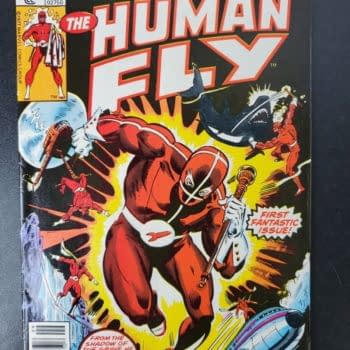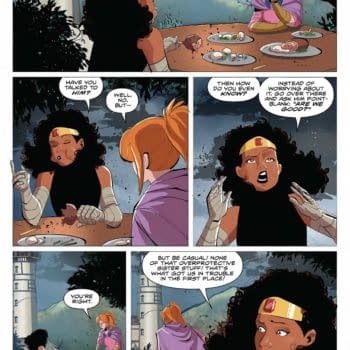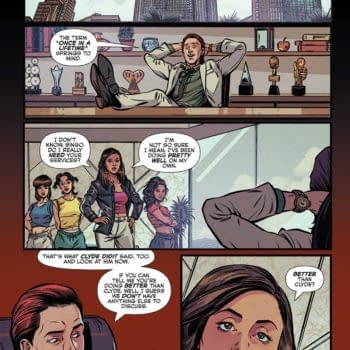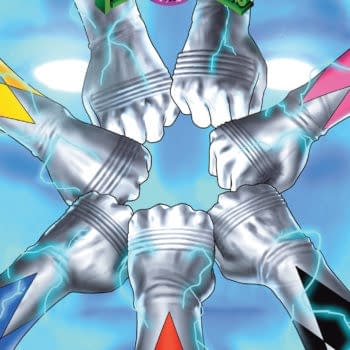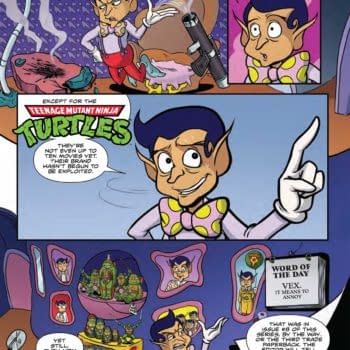Posted in: Comics, Recent Updates | Tagged: Annihilator #1, Comics, dan didio, dc comics, Edge of Spider-Verse #1 Spider-Man Noir, entertainment, Futures End Month: Week 2, grant morrison, jim lee, Legendary Entertainment, Marvel Comics, Paul Levitz, scott snyder, Sixth Gun: Volume 1, Teen Dog #1
Thor's Comic Review Column – Edge of Spider-Verse: Spider-Man Noir, Futures End Month: Week 2, Teen Dog, Sixth Gun: Vol. 1, Annihilator
This week's reviews:
Edge of Spider-Verse #1 – Spider-Man Noir
Futures End Month: Week 2
Teen Dog #1
Sixth Gun: Volume 1
Annihilator #1
Edge of Spider-Verse #1 – Spider-Man Noir
By Adam X. Smith
Let me preface this review by saying that, as it will soon become apparent, I've not read any of the Marvel Noir titles before – and thankfully nor is it particularly necessary to have done so – so I have no prior feelings one way or the other about that aspect of this book. Also, while the little checklist in the back of Edge of Spider-Verse #1 lists Superior Spider-Man #32 as ground zero for this storyline (reviewed by our own Cat Taylor a few weeks ago), if I have to read another bloody issue of Superior Bloody Spider-Man it'll be a hundred billion bloody years too soon.
So anyway…
Just when I thought there wasn't going to be something to occupy my attention during the month of September – you know, besides fresher's week preparation and downsizing my DVD collection – it turns out that for the first time Marvel has a crossover going on in competition with DC's annual 3D-cover-a-thon that I actually want to read. And lo and behold, I actually want to follow it all the way through (barring the aforementioned Superior malarkey).
Some of you are bound to be thinking, Adam you subterranean homesick alien, you haven't read a DC crossover since the days of Countdown and Final Crisis – what do you know about what makes a good crossover event?
Well, Mr.-and-Mrs.-Voice-In-My-Head, so far it's got the following going for it: it's a Spider-Man comic that doesn't require an exhaustive opening paragraph to set up or an encyclopaedic knowledge of the characters to follow – just a title, a premise and the promise of getting to see every previous iteration of Spider-Man ever and even some new ones along the way.
Oh Hosanna, it's the lesser of two evils!
And also it's a great introduction to writers and artists I wasn't familiar with – double trouble! Artist Richard Isanove (The Dark Tower: The Gunslinger Born) joins Spider-Man Noir co-creators David Hine and Fabrice Sapolsky in reimagining Peter Parker as a pulp-noir influenced hero complete with goggles, lots of leather (including what can only be described as a gimp mask) and revolver*, and whilst that description wouldn't have set my world on fire on its own, it gives us a pretty interesting reinterpretation of all the supporting characters and villains, including Quentin Beck aka the Magnificent Mysterio as a conjurer and small-time member of Wilson Fisk's outfit hoping to steal Spider-Man's blood in order to use its secrets to take over New York because reasons.
Not a great plot admittedly – it's essentially ripping off the god-awful Amazing Spider-Man movies' obsession with magical blood, which under different circumstances would annoy the living piss out of me; the reason it doesn't is that this universe's Spider-Man's powers do actually seem to be partially supernatural ala The Shadow or The Phantom – he gained them from being bitten by a spider that came out of an African totem of the spider-god Anansi, and Mysterio's powers appear to be based on some sort of combination of Amazonian hallucinogenic gases and steampunk machinery. Slight as the issue may be in terms of plot substance, it sets up greater electricity to come with a vague threat that requires the attention of multiple Spider-Men from across the multiverse.
Speaking of Spider-Man crossovers, the last one I read that really put me in a good mood was Brian Michael Bendis and Sara Pichelli's Spider-Men, because I knew the characters and the creative team understood what was cool and interesting about the idea of pitting mainstream universe Peter Parker against the slightly-differenty villains of the Ultimate Universe, it allows for him meeting his alt-universe successor Miles Morales and we see the effect it would have on the bereaved members of Ultimate Spidey's family and friends. Conversely, when I found myself reviewing Superior Spider-Man #17 last year(the events of which are supposedly tied up with this, natch), it was entirely possible I gave it an unfair appraisal, but frankly I'll not lose sleep over not giving a shit enough about Spider-Man 2099 to care about him being in a comic I was already highly dubious of.
So yeah, week 1 down. Next week, I meet Spider-Gwen. Peace out, y'all!!
*I'll let more informed minds than my own decide whether this series is more "noir" or "pulp" for themselves – it basically falls neatly in the middle of the sliding scale roughly between The Rocketeer and The Shadow in terms of aesthetic – lacking the depth of a Dashiell Hammett novel but not as completely lacking in subtlety or nuance as post-Sin City Frank Miller. Also, my research tells me that Noir Aunt May is a Commie sympathiser, not that I could tell.
Adam X. Smith is a paranoid android from the Planet X. For the last 27 years he has been living amongst the people of Birmingham, England (and more recently the University of Lincoln) ostensibly as a student of the school of hard knocks (also BA Hons Drama), but secretly on a mission to scout out the planet for invasion by alien forces; his weekly communiques on his various blogs are actually highly coded messages to his extra-terrestrial masters. He enjoys the musical stylings of local chiptune-metal band Elmo Sexwhistle, the fiction of Kim Newman, Kurt Vonnegut and Chuck Palahniuk, and his hobbies and interests include film-making, drama, occasional Youtubing, journalism and plotting the subjugation of humanity. He can be found on Youtube, Tumblr, Twitter or by jamming an ice-pick through the optic chiasm.
Futures End Month: week 2 (DC Comics $2.99/$3.99)
By Graig Kent
This "Futures End Month" at DC is a gnarly beast. Futures End, the weekly series, is set "5 years in the future" –which should actually be "5 years in the hypothetical future. The "zero" issue that kicked it off established a Terminator-like 30-years-from-now future where humanity is overrun by Borg-like beings and controlled by the Brother Eye satellite which Batman Beyond is sent back in time to destroy. This appeared to be the focal point of the series, spending time in the near future to avert a greater disaster in the further future. But 20 issues into the weekly, and a dozen-and-a-half one-shots later, it seems so much less focused on stopping what's coming, and instead on building a whole new New 52 landscape that may or may not exist in 35 weeks, nevermind 5 years from now.
The world that Futures End is trying to establish is one that's post-war, after a devastating conflict between Earths 1 and 2 (dubbed "The Earth War", which, it's teased, will spill out of the Earth 2: Worlds End weekly that starts next month). The one-shots that are replacing DC's regular roster of ongoing titles seem to be of three types: a) attempting to tie into the events told in the weekly series, b) telling a self-contained story using the title's characters and the event's setting, or c) trying to "catch the reader up" on the intervening years. The problem with a) is it's so easy to contradict or conflict with what's established in the weekly, while b) has the problem of feeling disconnected to the weekly (although it may have the advantage of feeling more connected to its own ongoing title). Then there's c) which, as I noted last week , can feel tedious if repeated too often, or not actually lend itself to telling an actual story.
Since the advance solicitations have been untrustworthy as to the creative teams involved and vague on the story being presented, it's sheer guesswork as to what type any particular one-shot will fall into. My pulls for "Futures End Month" have so far been those I thought would tie in strongly, based on the characters involved in the weekly that have their own ongoing book or written by the creative quartet who are writing the weekly.
Of this week's crop I figured that World's Finest, Suicide Squad, Justice League United and Constantine would all feature strong tie-ins. Turns out I was batting .250, and even then, "strong" is probably not the best adjective to use. World's Finest: Futures End in particular tries to be a strong tie-in but is highly unfortunate in its execution. Issue 19 of Futures End this week features a Brother Eye-controlled Power Girl taking on Fifty Sue and Deathstroke, while World's Finest features the exact same thing. Sure the timeframe of World's Finest is from a few weeks earlier in the weekly's story (as witnessed by Hawkgirl's transition from pen to the lab) but it's still awkward timing, made even more awkward by the outright contradictions between the two issues (for one, Power Girl burns her costume as she goes undercover in World's Finest, so how is she wearing it in Futures End 19?).
Even though Keith Giffen, writer of the Cadmus Island segments in the weekly, is credited as an "advisor", there's still some faults in Paul Levitz's script linking this series to the other. As well characters are presented differently, (Fifty Sue, for instance, sounds like Mindy from Animaniacs rather than the petulant-but-intelligent pre-teen Giffen writes). This, I believe, is the first in-costume appearance of Tanya Spears as Earth 1's Power Girl, but she doesn't even get referred to by name (I had to look up who she was supposed to be on the internet). This one's only for readers picking up both World's Finest and Future's End.
With Suicide Squad: Future's End I was expecting a stronger tie to the weekly based on Slade Wilson's involvement in both series. However, Slade doesn't appear (at least not the true Slade) in this unquestionably dumb issue that finds a jacked-up Amanda Waller freeing her old team of Deadshot (minus an arm), Harley Quinn (injected with Bane's venom) and Black Manta (fish sticks…don't ask) from Belle Reve in order to destroy a secret government facility. That facility makes clones of bad guys so they can have an endless supply of violent, crazy mercenaries to throw out into the world. It's so mind-numbingly dumb (it's a return to "extreme" comics of the1990's), both in conception and execution, as the team faces off against pre-teen Joker twins and a punk-kid Deathstroke, and outright contradicts the Batman: Futures End book from this week in regards to cloning and who can do it. Waller shows strange, out of character compassion and empathy for her old team, while two of the four players are reduced to rather mindless brutes. Also, if you thought Harley's outfit was terrible before, you've not seen how truly crappy it looks it when she's all beefed out on venom juice in it. Skip it with extreme prejudice.
As a chief architect of Futures End, Jeff Lemire has been able to seed his just-started Justice League United team as an important part of the DC Universe through the weekly he co-writes. Up until now it's been with only loose ties, like the reveal of Hawkman's regenerative ability in both series and the burgeoning buddy bond between Green Arrow and Animal Man. With Justice League United: Futures End he presents the future of the team in flux in no small part due to Green Arrow's death, but establishes Equinox who has just received her powers in the modern day as a veteran hero of the North five years hence. The plot here is independent of the Futures End weekly and carries over as a two-parter into next week's Justice League: Futures End. It's an intriguing glimpse into the Justice League's future, with a look at familiar (Flash, Cyborg), unexpected (Dawnstar) and new players (Stormguard, Vokstok) alike, somewhat reminiscent of the reveal of the Justice League Beyond in the DC Animated Universe.
This, like Green Arrow last week (also written by Lemire) acts as continuance of its own regular title while it remains to be seen (next week) if it's more deeply connected to Future's End. In does however present a story that feels like it could actually exist independently of both its own series and the event it ties into, so a second issue of this is welcome. For Justice League United readers it does pay off nicely what we've seen from that series' short run so far and for what's promised coming up (Legion of Super-Heroes). For Future's End readers, it's likely inessential.
I realize it may be because I'm a regular reader of books like Green Arrow and Justice League United and not Suicide Squad or World's Finest or Earth 2 that I may find them more engaging, but then there are the Futures End Month books for Grayson and Constantine that present exquisite done-in-one character stories that only marginally apply "the 5 years later" conceit (it's otherwise irrelevant), thus making them equally accessible to readers of either series AND readers of neither. Constantine: Futures End doesn't relate to the story at all as he is involved with in the weekly (where he has been on a mission to find Superman and stop the oncoming ancient evil), but instead pits him face to face in a final duel with the helmet of Fate (the story perhaps ends in him going on the bender that he awakens from when he first appears in the weekly). The battle of wills with Fate is epic, and presents both characters in their New 52 incarnations in a way that makes them accessible for new and old readers alike.
If anyone interested in the forthcoming NBC TV show is curious about who this character is, this is actually a surprisingly good place to start. Series writer Ray Fawkes definitely has a voice for the character and the milieu he operates in, while artist Juan Ferreyra provides a nice hybrid style that reads both modern mainstream and classic Vertigo (bringing hints of Rick Veitch into the mix) well-complemented by Tanya and Richard Horie's chalklike colors. A thoroughly solid read.
Like Green Arrow: Futures End, which served as an epilogue to Lemire's run on that book, so too does Batgirl: Futures End, serve as an epilogue to Gail Simone's turbulent run on this series. This issue begins not five years in the future, but rather only two, on Barbara Gordon's wedding day. A traumatizing event occurs, and Barbara goes dark, real dark, delving into the Gotham underworld and dismantling from within. Three years later she's the estranged prodigy of Bane, under the guise Bete Noir — "the Beast" — controlling Gotham's crime through her League of Batgirls (Cassandra Cain, Stephanie Brown, and Lucius Fox's daughter Tiffany). When her mentor returns, fully aware of her duplicity and none to pleased, Barbara tries to find herself again — having been lost for so long — in order to face Bane on her own terms instead of his. It's an odd issue, as if Simone is laying out all of her now-abandoned plans in one fell swoop, but it's still a thoroughly engrossing read which feels much bigger than its 20 pages. It's a shame its not still ongoing (or able to branch off from here) because the League of Batgirls is something I would truly enjoy reading (either by Simone, or Brian Q. Miller perhaps?).
Simone, having recreated the character in Secret Six a few years ago, writes Bane like no other (I presume he'll be part of her team in the New 52 iteration), and it shows even in his brief moments here that she has him wrapped around her finger. She can make him do anything and it will work. While I'm excited for Batgirl's new direction next month, and I all but ignored Simone's run to date, this issue has made me realize we've missed out on something great, if not what's passed then what might have been. A great stand-alone pick-up, but a must have for Simone's Batgirl followers.
Finally, for this week, for me at least, there's Batman: Future's End, from Ray Fawkes (again) with story by Fawkes and Scott Snyder. To me there's one key sign that a Batman story is written well, and that if I hear Kevin Conroy's voice as Batman when I read it. Snyder's run to date has consistently provided that, and Fawkes' five-year-later vision for Batman provides it here. Hinted in Batgirl (and perhaps explored in Detective Comics: Futures End last week?), Bane broke Batman's back at some point, and Bruce is using all sorts of exoskeletal parts and a cocktail of drugs to keep Batman functional. In the Futures End weekly there is talk of Superman being a symbol the people need to feel safe, while here, Bruce feels that Batman is not just a symbol, but a presence that's necessary to keep evil at bay. Only in his early 30's 5-years-later, Bruce's body is failing him. He needs to be fixed, or he needs a new one. Only one man can provide him what he needs, and it's up to Bruce's own broken, artificially- enhance self to bust into Lexcorp and take it. Is stealing from evil people still stealing?
While I find I'm skeptical about the set-up of the story (is Bruce really so adamant about continuing his mission? Why no mention of the Lazarus pit?) the actual execution is a riot, pure excitement and fun through and through. Lex Luthor's security defence recordings are hilarious, and when another certain Superman villain crashes the scene it gets crazy. Artist ACO provides very dramatic, stylized heist action reminiscent of Jock and Michael Lark, and it's a thoroughly well produced book. It works as a tremendous stand-alone Batman tale, and it fits somewhat okay with Futures End elsewhere (though Bruce has had little presence so far in it).
Overall the ratios are about the same as last week, with a seeming 1 great to 1 good to 1 not-so-good. Again, it's been left up to the reader to discover on their own which are which (by shelling out $3, or $4 if its the not-so-impressive lenticular covers), but Jim Lee and Dan Didio provided hints last week that Green Arrow, Superman, Grayson, and Booster Gold were perhaps the highlights of the month (with Didio shilling for his own books Infinity Man and the Forever Peiople as well as Trinity of Sin: Phantom Stranger). We'll see next week with reviews for Batman/Superman, Justice League, and Teen Titans.
Graig Kent is full of lies. He's mostly occupied by playing Marvel Puzzle Quest incessantly. It's a wonder that you're even reading this. He can be found on twitter @thee_geekent and his dog has a blog… tacomblur.tumblr.com
Teen Dog #1 (BOOM! Box)
By Bart Bishop
I've noticed a strange trend recently with my age bracket: nostalgia for the 1990s. It's really not surprising considering the culture of the United States goes through 20-year cycles, but it is disconcerting when 30-year-olds are still watching reruns of Power Rangers unironically (or ironically, for that matter). For the longest time nostalgia for the 1980s permeated the lifestyle of the average millennial on the older end of the 18-34 age bracket, and that felt justified considering how potent that decade is for examination in terms of both quality and bizarre implications.
The 1990s, however, in retrospect feel like a naïve transition between the late '80s yuppieism and the severity of the early '00s, and Boom! Box's new title Teen Dog attempts, of all things, a meditative bridging of that tension. Its own marketing trumpets it as John Hughes meets '90s Nickelodeon, but while the former teen films had the edge of the lost generation of Gen-Xers reeling from the aftershock of their flower child parents, the likes of Doug and Saved by the Bell were watched in the aftermath of the Soviet Union's collapse, potential peace between Israel and Palestine, and the promise of global warming and pollution being wiped out by smiles and hand holding. Teen Dog, writer/artist Jake Lawrence's spinoff of his Time Cowboy webcomics, channels that pastel-bedazzled optimism, but the underlying hint of snarkiness prevents it from making any meanwhile commentary on its chosen setting.
So the premise is simple enough: it's a vaguely surreal time period circa 1991, set in a high school of a vaguely Midwestern town that the kids from Chynna Clugston's Blue Monday would be comfortable in. Teen Dog is the protagonist and is, naturally, the coolest guy in school. The most obvious comparison is Poochie from The Simpsons, a cartoon dog "with an attitude" introduced on The Itchy & Scratchy Show to update it with modern appeal. The comparison, in fact, is so palpable as to be unequivocally intentional on Lawrence's part. There's a fine line being walked, however, as Teen Dog really is just that cool.
He drifts through a school day, and presumably every school day, like Jeff Spicoli minus the consequences, accompanied by his best friend Mariella. Mariella is a punk rocker, but a nice one, and she and Teen Dog tackle typical teen life including cliques, bullies and dreaded homework. There's a pleasant amount of diversity, with persons of color Mariella herself as well as football players Jim and Sara Sato, breaking down multiple barriers by also being a girl playing football. There's also the fact that Teen Dog and Thug Pug are the only anthropomorphic animals in the comic, but that just contributes to the overall surreality of Teen Dog.
And it's existentially mind melting. When BOOM! Studios launched BOOM! Box last year, they promised the new imprint would vary in genre, tone, format and creative vision with a focus on creating comics purely "for the love of it" while bringing in creators from outside the direct comic market. Lawrence certainly checks every box in that criteria. Strangely enough he grew up in Australia, but has stated in interviews that a lot of Teen Dog is taken from personal experience and that there's a lot of crossover between American and Australian youth culture. That's fairly clear, as he's nailed the breeziness and navel gazing of adolescence but also the sense of wonder at the possibilities not just of the future but of everyday life. What really seals the deal is the nonchalance with which Teen Dog engages with his own awesomeness: he possesses, for example, the Teen Dog Touch that enables people to transcend time and space and achieve a kind of nirvana, yet his only response to this is a laidback, "Radical!"
This is especially accented and complemented by the art, character designs and page layouts. Lawrence goes for an especially cartoonish style reminiscent of the aforementioned '90s television shows, but with a crude aspect that is still fully functional, appropriate and cute in its sense of funk. The character designs, meanwhile, are varied and pointed, with Mariella for instance sporting pink hair with something resembling a devil lock plus pony tail, and Teen Dog as mix of The Breakfast Club's Bender and The Fonz. Each character is signified by their clothes, haircuts and caricatured body types, but every scene has a clear sense of geography and spatial relation. This is highlighted by the winking at the reader of the titles of each section, floating above and outside the page panels. Not only does it hearken back to the webcomic roots, but it adds a referential subtext to each scene. While some are as simple as "Factions" for a discussion of cliques, there's little in-jokes like "Alright Alright Alright" that, for those that have seen Dazed and Confused (or just been alive these last 20 years) get the Matthew McConaughey shout out.
Still, I can't help but feel that this entire premise is predicated on little references like that that are more mocking the tropes of childhood rather than engaging with them. It's all light and fun, but in the end Teen Dog recreates a time period without having anything to say about it.
Editor and teacher by day, comic book enthusiast by night, Bart has a background in journalism and is not afraid to use it. His first loves were movies and comic books, and although he grew up a Marvel Zombie he's been known to read another company or two. Married and with a kid on the way, he sure hopes this whole writing thing makes him independently wealthy someday. Bart can be reached at bishop@mcwoodpub.com.
Sixth Gun volume 1 (Oni Press, $59.99)
By Cat Taylor
I've heard a lot of great things about this series and fortunately, it mostly lives up to the hype. In plot and premise, it is similar to the better issues of Jonah Hex – the ones where the western elements and supernatural elements are in balance and handled by someone who knows how to write both. However, in tone and execution, I found it reminiscent of another excellent series you may have heard of before called Fables. Although I can't say it quite rises to that lofty expectation, it is pretty darn good. As a first time reader who didn't have the foresight to start buying and keeping up with the story when it was originally published, I found this collected format of the first two story arcs with a prose back-up feature to be the kind of introduction that really sold the hype and allowed a new reader like me catch up on the Sixth Gun world. According to the publication date on the inside cover, this collected volume has been in print since November 2013 but I was just made aware of it. So, perhaps this is new to you as well.
If you, like me, didn't know much about Sixth Gun before now, it's written by accomplished writer, Cullen Bunn. The story takes place shortly after the Civil War and is focused on six pistols with magical powers. In the first story arc, five of the guns are already possessed by five desperadoes. However, the sixth and most powerful gun is in the possession of one of the good guys, and the formerly dead leader of the villains has been brought back to life and is out to reclaim his property. Series artist, Brian Hurtt, has designed the villains to look really cool in the nastiest sort of way. Hurtt is probably best known for his work on Queen and Country, but he has also previously worked with Bunn on another series called Damned. After reading Sixth Gun, I can only assume that Damned must also be worth a look.
Sixth Gun flows in a manner that made binge-reading the first story arc an easy and exciting prospect. I can easily see how a person buying single issues of the series would be excited to get the new issue each month. While the action is fast-paced and the characters don't get a lot of chance for thorough development, we do learn enough about them to care and recognize each one as a unique individual rather than as generic stereotypes. Also, there are enough new elements in each issue that there is constant excitement beyond the main story. In this way, Sixth Gun also reminds me of another popular fantasy property, and that's the little cult movie, Star Wars. Just like Star Wars included so many unexplored events, characters, and planets that an entire expanded universe developed around it to be explored by fans and professionals alike, I can see a lot of the same potential for Sixth Gun. One of the villainous gun-owners for instance became my own personal Boba Fett. He's the character I thought looked especially interesting and dangerous and yet wasn't given nearly as much to do as would like to have seen. You'll recognize him because he wears a hood that makes him look like the character on the movie poster for the Town That Dreaded Sundown.
The second story in this volume contained quality material as well but comparatively suffered from a sophomore slump. Plot-wise, Bunn focused more on voodoo elements than on a more traditional western plotline. However, that's not why the story isn't as strong. Rather, I was able to see two major plot-twists very early and therefore the reveals lost their thrills. With regard to the third story, it's hard for me to evaluate it on an even field since it was all prose and Hurtt's Fables-like drawings and the vibrant colors from Bill Crabtree add a lot to the storytelling.
Overall, this is one of the better discoveries I've made in the comic book world. The only real weakness that that the story suffers is the same one that can be found in any action-adventure story, which is simply a lot of convenient strokes of luck and coincidences that save the characters, but I'd have to fault almost every work of fiction if I'm going to seriously criticize it for that. However, there is a real weakness in the book that has nothing to do with the creative team but with whoever assembled it. The first story arc quite clearly has several panels out of order on their pages. At first, I thought it was a fault of the sequential art, but soon I realized there was no getting around the fact that a bunch of them were obviously put in the wrong spots. That was a big disappointment but I was able to enjoy it anyway. A potential new reader may also balk at the lofty price tag on this trade paperback, but one should also be aware that this collection is 370 pages long. So, there is about three trades worth of material in one volume. The price might still be a little high for your taste but, considering the quality of the contents, it's worth a look anyway.
Cat Taylor has been reading comics since the 1970s. Some of his favorite writers are Alan Moore, Neil Gaiman, Peter Bagge, and Kurt Busiek. Prior to writing about comics, Taylor performed in punk rock bands and on the outlaw professional wrestling circuit. During that time he also wrote for music and pro wrestling fanzines. In addition to writing about comics, Taylor tries to be funny by writing fast food fish sandwich reviews for Brophisticate.com. You can e-mail him at cizattaylor@hotmail.com.
Annihilator #1 (Legendary, $3.99)
By Jeb D.
It's been a while since I've thought of Grant Morrison and Mark Millar in the same context (probably since their joint appearance in a Simpsons comic), but the first issue of Morrison's Annihilator reminded me a great deal of Millar's Starlight #1 that I reviewed a few months back: Annihilator and Starlight are both high-concept series with a foot in sci-fi, and their first issues are both basically elevator pitches; by the end of each issue, you pretty much know just as much as you did about the comic as you did when you read the initial solicitation, and story proper will get underway next time.
I have no idea how Starlight developed past issue #1, because Millar really didn't do anything with the first issue but restate the marketing hook: a Flash Gordon-type adventurer, now returned to the mundane earthly life he once led, is called back into outer space for one last mission. It may be that subsequent issues unlocked secrets of the universe (barely plausible), delved into the meaning of life (unlikely), or maybe tossed in a bunch of sex and violence (decent odds); but because Millar's initial setup was so reductive and obvious, I was never compelled to keep reading.
And, oddly for a Grant Morrison comic, I came away from the first issue of Annihilator with a similar feeling: the basic premise is familiar from his previous work (a "story" merges with "reality"), and given that, you'd expect him to move quickly past the setup, and find the hook that will make this comic stand out from what he's done in the past with The Invisibles or Animal Man (or, for that matter, what Warren Ellis did with Planetary, or Mike Carey is doing with The Unwritten).
Ray Spass is a blocked, hard-drinking Hollywood screenwriter, desperate to finish his latest screenplay before an inoperable brain tumor claims his life. He inexplicably finds the inspiration to craft a story about space adventurer Max Nomax. But Ray finds he can't finish the script and abandons hope; we see him with a bottle in one hand, a pistol to his chin in the other… and the sudden appearance of a (presumably) flesh-and-blood Max Nomax in the room with him, ready "to cure death!". Up to this point, Max's story has run in parallel with Ray's, so it's not exactly a surprise to the reader to see him turn up: we're aware, long before Ray is, that Max is not only real, but he's on a quest that might save Ray's life.
Granted, part of what today's comics writers are dealing with is just the nature of serialized storytelling, but for all that ongoing comic series share some of the characteristics of TV series, there's a crucial difference: the typical business model for TV doesn't require the consumer to pay separately for each new episode (whether you're talking broadcast TV, cable channels like HBO, or subscription services like Netflix; that's also true of those who binge via box set… much like readers of trade paperback comic collections). It's not unusual for a TV critic to comment on the fact that a new series might have taken several episodes, or even seasons, to really "find itself"; comic book fans who took a chance on ABC's Agents of Shield surely understand this: no one who suffered through the dreary first few episodes of that show would have kept dropping another nickel in the slot to see if it got better. But when the only cost to continuing was an hour a week (and maybe a few brain cells), there was the modest reward of seeing it actually turn into something entertaining, with the tie-ins to Captain America The Winter Soldier, and cast additions like Jaimie Alexander and Bill Paxton.
But so long as the comic book business relies on the single-issue model (even just to promote the eventual trade release), a first issue has to do more than set the table: it's got to reach out and grab the reader, persuading them that they'd rather spend next month's four bucks on Annihilator #2 than on someone else's book. At this point, I'm certainly curious to see if Morrison has any ideas about the relationship of an author to his reality that are an advance on what we've got in the past from, say, Rod Serling or Ray Bradbury… but I feel a far greater need to put my four bucks toward what happens next in Uber or Rachel Rising—two books, by the way, which present an interesting contrast in how to start a modern comic series: the first issue of Uber lays out its premise briskly but effectively, and is crammed with incident, exposition, characterization, action, and an inescapable "come back next issue" hook; while Rachel Rising took nearly a dozen issues to fully reveal its purpose, peeling back just enough layer of mystery each issue to keep us intrigued.
This is, of course, not to discount Morrison's long track record: there's virtually no chance that he's going to spend a half-dozen issues operating at this fairly mundane level of inspiration; he's quite capable of pulling a major mindfuck out of midair at anytime. But, really, that speculation is about the only thing that would get me to consider additional investment in the title.
Artist Frazer Irving, who previously illustrated the Klarion the Witch Boy segment of Morrison's Seven Soldiers, brings an appropriately creepy style to the dark proceedings, and some nicely cinematic layouts. The actual execution of the finished art is a bit distancing, with odd effects like the long hair on the unshorn side of Jay's head often seeming to float on a different plane of existence from the rest of him.
One odd little note: the back of this issue has a six-page preview of an upcoming Legendary comic, Epochalypse (from Jonathan Hennessey, Shane Davis, and Morry Hollowell) that has some of the freewheeling feel of a Morrison comic like Seven Soldiers or Multiversity, and purely on what we see here of the plot and setting, looks like it could be the more rewarding investment.
Annihilator is a must for Morrison fans, obviously, and new comics from Frazer Irving are always a treat; but if you're on the fence about either of them, I'd say you can tradewait this one.
Jeb D. is a boring old married guy whose comics background includes attending the very first San Diego Comic-Con, being lectured on Doc Savage by Jim Steranko, and fetching an ashtray for Jack Kirby. After a quarter-century in the music biz, he pursues more sedate activities these days, and will certainly have a blog or Facebook account or some such thing one day.




















